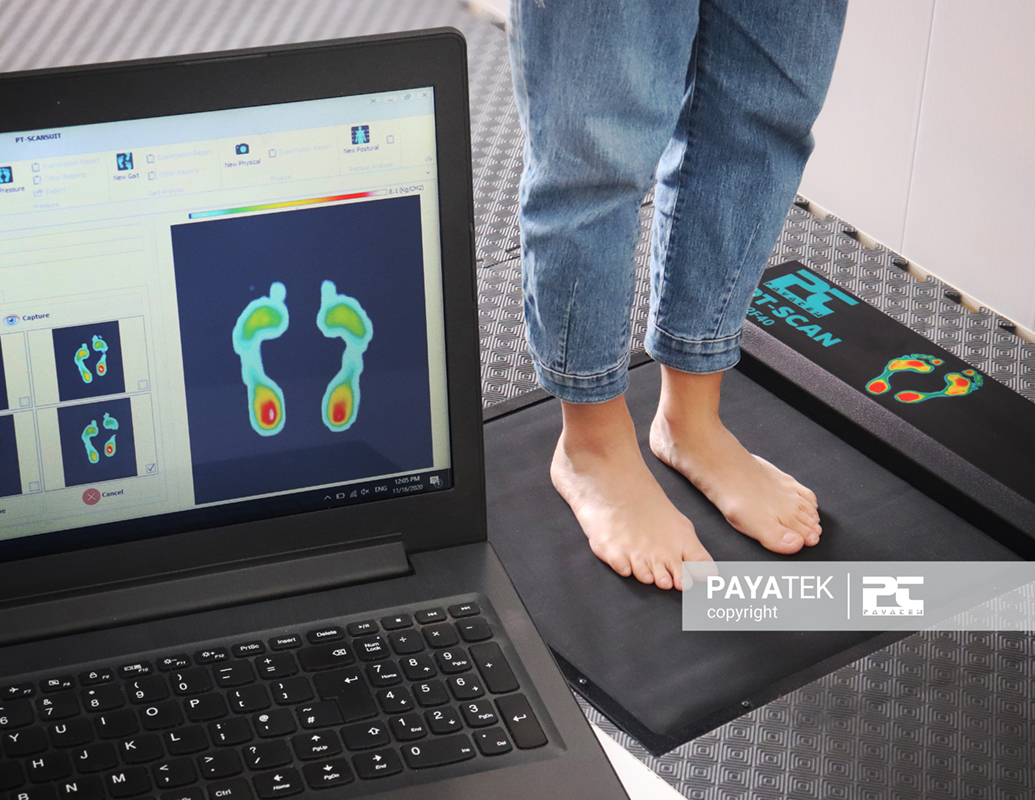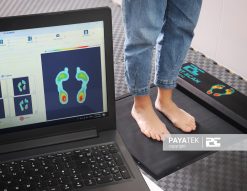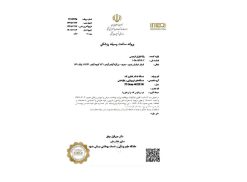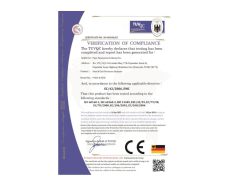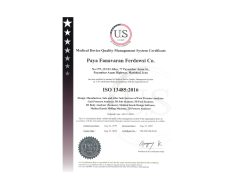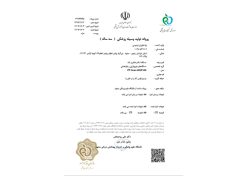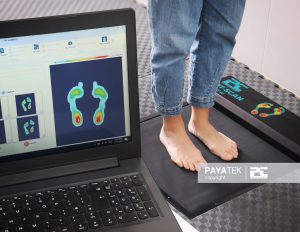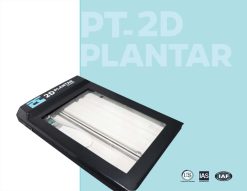Foot Pressure Scanner
Foot pressure scanner | PT-SCAN | is a precise platform for foot pressure mapping, capturing all relevant data and specialized graphs essential for foot pressure analysis across three test modes: static, dynamic, and balance.
PT-SCAN delivers high-resolution scanning of plantar pressure in minimum time, accurately defining the distribution profile of foot pressure with its advanced high-speed pressure mat sensor technology over 2200 sensors.
CE
Certified by IMED
ISO13485 certification
Electrical safety standard certification – IEC60601-1
EMI/EMC standard certification – IEC60601-2
————————–
Quick Online Contact
Foot Pressure Scanner | PT-SCAN
The PT-SCAN Foot Pressure Scanner is a high-resolution, high-speed device designed to capture plantar pressure and force during both standing and walking (stance phase) for both adults and children. It records and analyzes foot pressure with exceptional accuracy, providing valuable insights into the distribution of pressure across the foot’s sole.
PayaTek’s Foot Pressure Scanner is an accurate and cost-effective solution for measuring the pressure exerted on different parts of the foot. It collects high-resolution scans and creates a detailed plantar pressure profile to aid in diagnosis and treatment planning.
Designed to meet the needs of specialists, the PayaTek Foot Pressure Scanner allows for a thorough examination of foot function, balance, and gait. Its powerful software enables precise analysis of foot pressure during standing, walking, and maintaining balance, ensuring that specialists have the information needed to select the most effective treatment.
With PayaTek’s Foot Pressure Scanner, specialists can easily measure and examine any part of the sole with accuracy. The system provides reliable and easy-to-interpret data on foot performance, including high-quality graphics and key indicators such as the center of pressure (COP), gait line, and maximum pressure during plantar contact.


High Speed sampling rate - 200HZ up to 400HZ


Spatial resolution of 1 sensor/ 0.7 cm2


Providing accurate kinesiology diagrams in addition to complete static, dynamic and balance test reports


PayaTek's integrated scansuit software
Effective integrated foot scan
The PayaTek Foot Pressure Scanner offers comprehensive foot analysis with three distinct scan types: static, dynamic, and static balance.
- Simplified Patient Follow-Up: Effortlessly generate and store patient files, including all test results, directly within the software.
- Enhanced Diagnostic Accuracy: Measure mean foot pressure and maximum pressure for precise and reliable diagnoses.
- Advanced Dynamic Testing: Visualize the center of pressure during dynamic tests with a high frame rate of up to 200 frames per second.
- Display the center of pressure in dynamic testing at a maximum frame rate of 200 frames per second.
Analyzing Body Posture and Standing with a Foot Pressure Scanner
The PayaTek Foot Pressure Scanner enables detailed assessment of body posture and standing by analyzing weight distribution.
Improper weight distribution is a common disorder affecting the skeletal system, particularly in the legs. In a healthy individual, the body’s center of gravity is evenly distributed between both legs in a standing position, placing the center of pressure equidistant from each leg.
However, some individuals tend to shift most of their weight onto one leg (either left or right), causing the center of gravity to move to that side. Others may place excessive weight on their toes, pushing their center of gravity forward, or on their heels, shifting it backward. These imbalances highlight potential musculoskeletal disorders requiring attention, preventive measures, and appropriate treatment.
The PayaTek Foot Pressure Scanner provides accurate and comprehensive reports on weight distribution, detailing how it is allocated across the left, right, front, and back areas of the feet. This information is essential for diagnosing and managing posture-related issues effectively.
Analyzing the Stance Phase of the Gait Cycle with a Foot Pressure Scanner
Gait analysis and biomechanics experts classify the gait cycle into two main phases: stance and swing. The stance phase occurs when the foot is in contact with the ground, while the swing phase begins when the foot lifts off the ground. In a normal adult gait cycle, this process includes three key stages: heel strike, stance, and toe-off. During this sequence, the heel first makes contact with the ground, followed by the midfoot, and finally the forefoot and toes. At this point, the body’s entire weight is supported by one leg.
For some individuals, due to conditions such as knee issues, pelvic misalignments, or nervous system disorders, the gait cycle is disrupted, resulting in an abnormal stance phase. These abnormalities can be effectively analyzed using the PayaTek Foot Pressure Scanner.
This advanced platform captures high-speed foot pressure data and provides precise reports, including:
- Center of Pressure (COP) and COP Line
- Frame-by-frame evaluation of foot contact with the ground
- Pressure distribution across different foot regions
- Floor reaction force
- Foot axis angle
Additionally, the scanner enables a detailed assessment of the patient’s gait pattern, offering invaluable insights for diagnosing and addressing biomechanical issues.
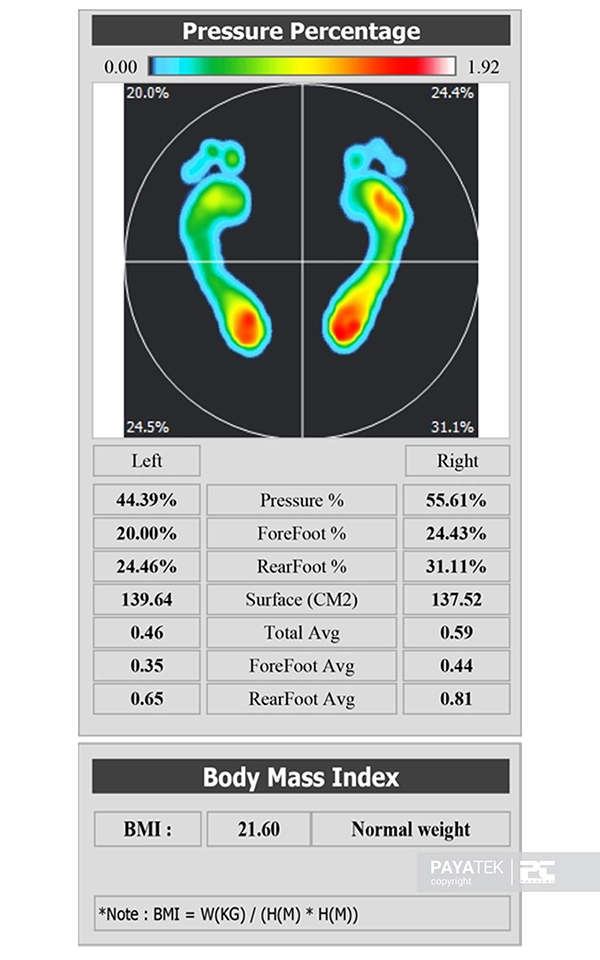

Analyzing the Stance Phase of the Gait Cycle with a Foot Pressure Scanner
Gait analysis and biomechanics experts classify the gait cycle into two main phases: stance and swing. The stance phase occurs when the foot is in contact with the ground, while the swing phase begins when the foot lifts off the ground. In a normal adult gait cycle, this process includes three key stages: heel strike, stance, and toe-off. During this sequence, the heel first makes contact with the ground, followed by the midfoot, and finally the forefoot and toes. At this point, the body’s entire weight is supported by one leg.
For some individuals, due to conditions such as knee issues, pelvic misalignments, or nervous system disorders, the gait cycle is disrupted, resulting in an abnormal stance phase. These abnormalities can be effectively analyzed using the PayaTek Foot Pressure Scanner.
This advanced platform captures high-speed foot pressure data and provides precise reports, including:
- Center of Pressure (COP) and COP Line
- Frame-by-frame evaluation of foot contact with the ground
- Pressure distribution across different foot regions
- Floor reaction force
- Foot axis angle
Additionally, the scanner enables a detailed assessment of the patient’s gait pattern, offering invaluable insights for diagnosing and addressing biomechanical issues.
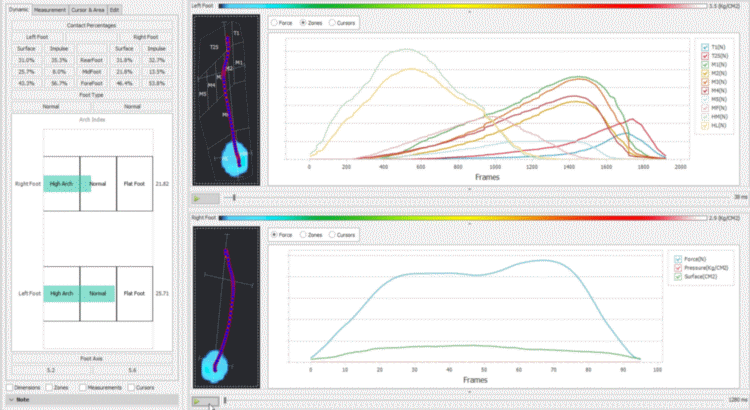

Assessing Balance with the PayaTek Foot Pressure Scanner
The PayaTek Foot Pressure Scanner evaluates patient balance using established methods such as the Romberg Test. During this test, the patient stands in a normal position on the foot mat while their center of gravity is monitored and recorded over a set period.
The scanner generates precise charts and pressure values, visually representing the patient’s center of force during standing. These detailed insights allow specialists to detect balance issues early and recommend tailored solutions to meet each patient’s needs effectively.


Key Applications of the PayaTek Foot Pressure Scanner
Diagnosis of foot arch type with both static and dynamic foot scan
The PayaTek Foot Pressure Scanner is instrumental in diagnosing foot arch types through both static and dynamic foot scans.
The sole of the foot comprises three arches:
- Two longitudinal arches (medial and lateral)
- One anterior transverse arch
These arches are formed by the tarsal and metatarsal bones, supported by ligaments and tendons. Structural problems in these arches often lead to pain in the legs and back, making precise evaluation essential for effective treatment.
A standout feature of the PayaTek Foot Pressure Scanner is its ability to detect the type of plantar arch and analyze the distribution of plantar pressure across both the longitudinal and transverse areas. This functionality is vital for identifying structural issues and guiding appropriate interventions.
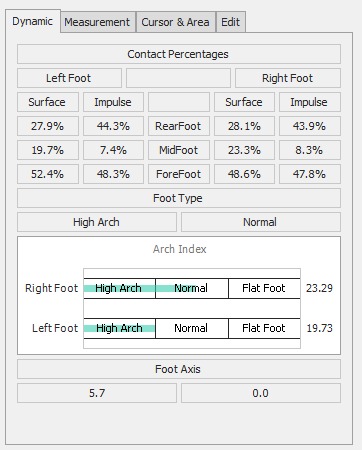

Below is an example of a foot scan report illustrating the pressure distribution and arch characteristics of a person with a flat foot.
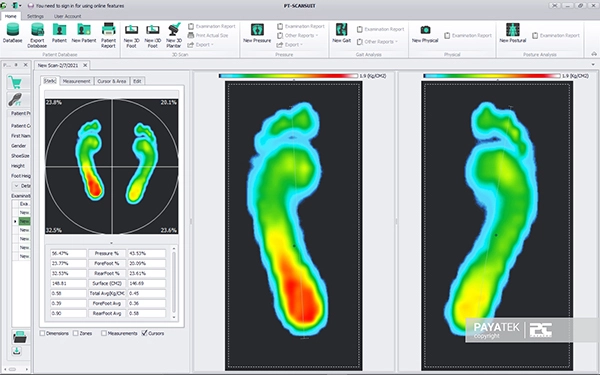

Example of a Foot Pressure Scan for High Arches
Individuals with high arches exhibit a distinct pressure distribution pattern. Below is an example of a foot pressure scan showcasing how pressure is concentrated in specific areas due to the elevated arch structure.
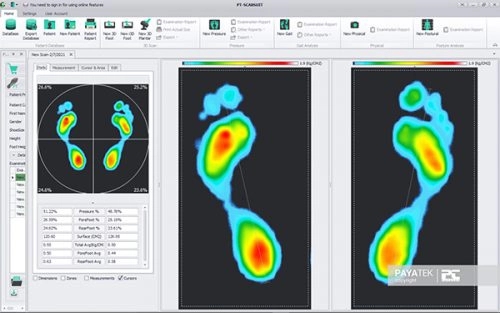

Automatic Foot Type Identification with PayaTek Foot Pressure Scanner
The PayaTek Foot Pressure Scanner automatically identifies the patient’s foot type by generating a detailed pressure image of the plantar surface. This data is presented to specialists as a comprehensive output report for analysis.
An example of the device’s report in detecting foot arch types is provided in the image below.
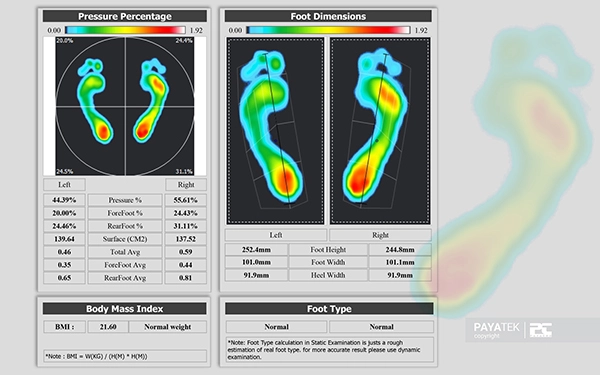

Identifying Ulcer-Prone Areas in Neuropathic Feet
Diabetic foot ulcers often result from skeletal deformities caused by neuropathy, leading to abnormal plantar pressure distributions. Research indicates that 20% of hospitalizations among diabetic patients are attributed to foot ulcers.
The PayaTek Foot Pressure Scanner assists specialists in identifying areas prone to ulcers in diabetic patients by detecting regions of high plantar pressure. This early identification enables preventive measures such as prescribing custom insoles and appropriate footwear, significantly reducing the risk of ulcers and improving patient outcomes.
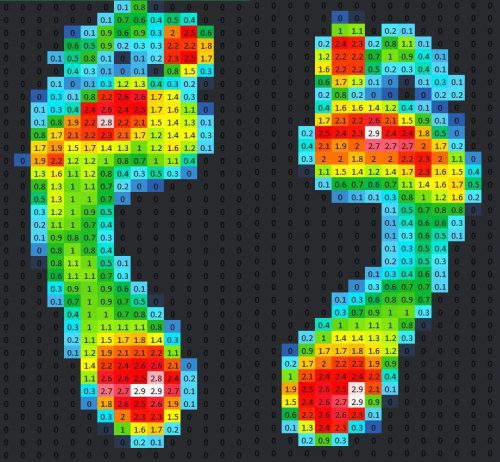

Lower Extremity Rehabilitation Exercise Training
Proper corrective exercises can effectively treat many conditions associated with foot and back pain. The PayaTek Foot Pressure Scanner ensures the intensity and direction of these exercises are precisely calculated, optimizing therapeutic outcomes and improving patient recovery.
Assessing Foot Pressure Asymmetry Between Left and Right Feet
Analyzing asymmetry in foot pressure profiles and force diagrams across the forefoot, midfoot, and rearfoot regions offers critical insights. This detailed evaluation aids in systematic analysis, disease diagnosis, and the development of precise and effective treatment plans.


Observing the COP Line and Dynamic Weight Transfer to Assess Postural Stability
The Center of Pressure (COP) line reflects the coordination between the nervous and muscular systems, making it a vital indicator of gait and balance. Abnormalities in normal gait and balance are readily detectable in the COP pattern.
The PayaTek Foot Pressure Scanner also analyzes the angle of the COP curve, allowing specialists to identify foot-related anomalies such as supination and pronation, providing a comprehensive assessment of postural stability and movement dynamics.
In-Depth Analysis of Foot and Gait Performance Using Balance Screen Charts
The PayaTek Foot Pressure Scanner provides a detailed evaluation of foot and gait performance by utilizing balance screen charts. These charts measure heel rotation during a step and assess the balance of force across the heel, midfoot, and forefoot.
By comparing these diagrams with normal patterns, specialists can accurately determine the optimal placement of corrective elements when designing customized medical insoles, ensuring effective and precise treatment solutions.
Monitoring Treatment Progress and Ensuring Plan Effectiveness
Patient satisfaction plays a crucial role in the success of any treatment plan. The PayaTek Foot Pressure Scanner enables specialists to track the healing process by monitoring changes in foot pressure and balance over time.
This device facilitates clear and effective communication with patients, building their trust in the treatment plan and enhancing overall outcomes. Regular progress checks provide tangible evidence of improvement, ensuring the treatment remains aligned with the patient’s needs.
Identifying the Cause of Leg or Back Pain with a Foot Pressure Mat
The PayaTek Foot Pressure Scanner provides detailed analysis of both maximum and average pressure on the sole of the foot. By pinpointing high-pressure areas in its reports, the scanner helps identify abnormal gait patterns, which are visualized in balance screen charts. This information is crucial for uncovering the root causes of leg or back pain and guiding effective treatment strategies.
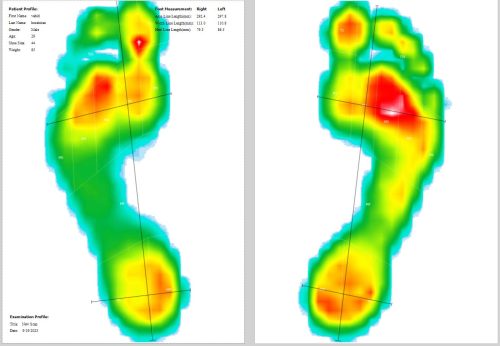



The powerful software of PT-SCAN allows detailed segmentation of the foot, enabling an in-depth analysis of foot function and precise identification of areas with the highest pressure. This ensures accurate, objective data for diagnosing foot function abnormalities and planning effective treatments.
PT-SCAN divides the foot into 13 distinct regions, providing comprehensive force and pressure-time data for each:
- Tarsal Regions: Tars 1, 2, 3, 4, 5
- Metatarsal Regions: Metatarsals 1, 2, 3, 4, 5
- Midfoot
- Heel Regions: Heel medial, Heel lateral
This advanced segmentation offers invaluable insights for understanding and addressing foot-related conditions.
Identifying Sensitive Ulcer-Prone Regions in Diabetic Patients Using a Foot Pressure Mat
Excessive pressure on specific areas of the foot sole during walking and standing is a primary cause of diabetic foot ulcers. These pressure points often occur in regions such as the heel, under the metatarsals, the arch (particularly in patients with Charcot’s disease), and the big toe.
Diabetes clinics prioritize foot ulcer management, and specialists utilize foot pressure scanners to identify high-risk areas in diabetic patients’ feet. This information is crucial for implementing preventive strategies, including prescribing specialized insoles and appropriate footwear.
Customized insoles are among the most effective treatments for reducing pressure on vulnerable regions, significantly lowering the risk of ulcers in diabetic patients and improving their overall foot health.
Examinations Performed by the PayaTek Foot Pressure Scanner
The PayaTek Foot Pressure Scanner (PT-SCAN) conducts three key tests:
- Static Test
- Dynamic Test (Gait Stance Phase)
- Static Balance Test
Static Test – Foot Pressure Measurement in Static Mode
In the static foot scan test, the patient stands normally and in a standard position on the foot mat. The software then performs the following analyses:
- Measures foot pressure distribution for each foot.
- Determines the foot arch type in the static position.
- Calculates the displacement of the body’s center of gravity.
- Evaluates symmetry between the left and right feet.
These examinations provide comprehensive data for understanding foot function and identifying potential abnormalities, aiding in accurate diagnosis and tailored treatment plans.
Dynamic Test – Foot Pressure Measurement in Walking Mode
In the dynamic foot scan test conducted by the PayaTek Foot Pressure Scanner, the patient walks normally over the device, taking a step and moving forward. Each foot (left and right) is analyzed separately.
The software generates comprehensive reports that include:
- The arch type during gait.
- The COP Line (Center of Pressure) for gait analysis.
- The foot axis angle for alignment evaluation.
- Identification of high-pressure points during the gait cycle, including average and maximum pressures.
This dynamic test provides critical insights into foot biomechanics, enabling specialists to diagnose gait abnormalities and design effective treatment plans.


Static Balance Test – Monitoring Center of Gravity Shifts While Maintaining Balance
The Static Balance Test in the PayaTek Foot Pressure Scanner evaluates a patient’s ability to maintain balance by monitoring shifts in the center of gravity.
During the test, the patient stands on the foot mat for approximately 10 seconds, striving to maintain a stable posture. The test duration can be customized based on the doctor’s requirements.
One of the recognized methods for assessing balance and proprioception is the Romberg Test, which can be effectively performed using this device. This test provides valuable data for diagnosing balance-related issues and planning targeted interventions.
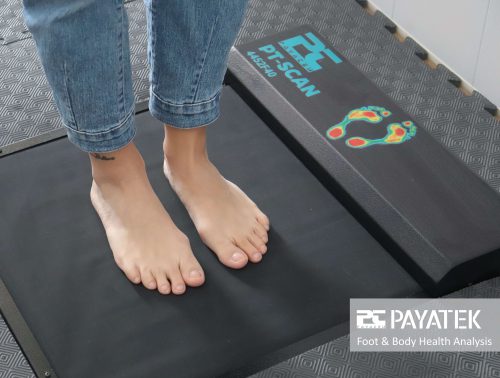
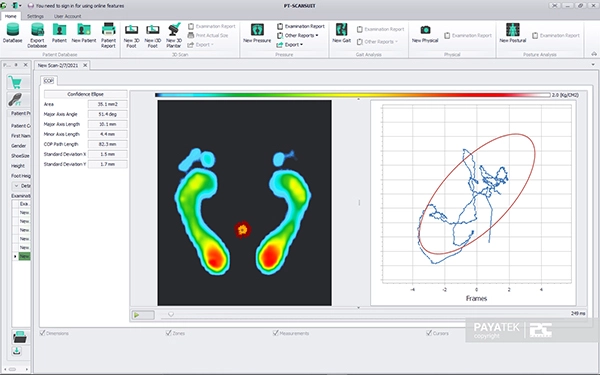

Who Uses a Foot Pressure Mat?
Foot pressure scans are widely utilized across various medical and therapeutic fields, including:
- Podiatrists – For diagnosing and treating foot-related issues.
- Orthopedics – To assess skeletal alignment and address foot deformities.
- Rehabilitation – For monitoring recovery and optimizing therapy plans.
- Physiotherapy – To evaluate gait and develop targeted treatment protocols.
- Corrective Exercises – To design customized exercise programs for improving posture and balance.
- Endocrinology – For managing conditions like diabetes-related foot complications.
- Diabetes – To identify high-pressure areas prone to ulcers and plan preventive care.
- Wound Care – To monitor healing and prevent further damage in high-risk patients.
These applications make foot pressure mats essential tools in both diagnostic and treatment processes.
Features of the PayaTek Foot Pressure Scanner (PT-SCAN)
- Smooth and Accurate Display: Provides precise visualization of foot pressure distribution.
- High Scanning Rate: Captures data at speeds of up to 200 Hz.
- Comprehensive Testing: Performs three key tests – static, dynamic, and static balance.
- Low Mat Height: Features a mat height of just 0.7 cm for easy use.
- Plug-and-Play Technology: Simple USB connection for effortless setup.
For in-depth analysis of human gait, explore our Gait Analyzer for advanced functionality.
| گارانتی | |
|---|---|
| کیف حمل | دارد |
| دوربین پشت پا | دارد |
| تعداد تست های قابل اجرا | 3 تست (ایستایی، داینامیک ( راه رفتن)، تعادل ایستا) |
| رنج تفکیک فشار و دقت سنسورهای مجاور | 0.1 کیلوگرم بر سانتیمتر مربع |
| نمودارهای ماکزیمم و میانگین فشار در تست داینامیک | دارد |
| نمودار های بالانس اسکرین در تست داینامیک(حرکت شناسی) | دارد |
Specification
| Technology | Resistive sensor |
| Number of sensors | 2288 sensors in a 52*44 matrix |
| Spatial resolution | 1.4 sensors/cm2 |
| Sensing area | 40 x 40 cm |
| Data resolution | 12 bits |
| Pressure range | 0.5 to 100 PSI |
| Data reception frequency | 100 up to 200 Hz |
| Hysteresis | <3% |
| Sensing area height | 0.7 cm |
| Weight | 5 kg |
| OS | Windows x64 8/8.1/10/11 |
| Connection | USB2/USB3 |
| Ambient operating temperature | +30 to -15 Celsius |




